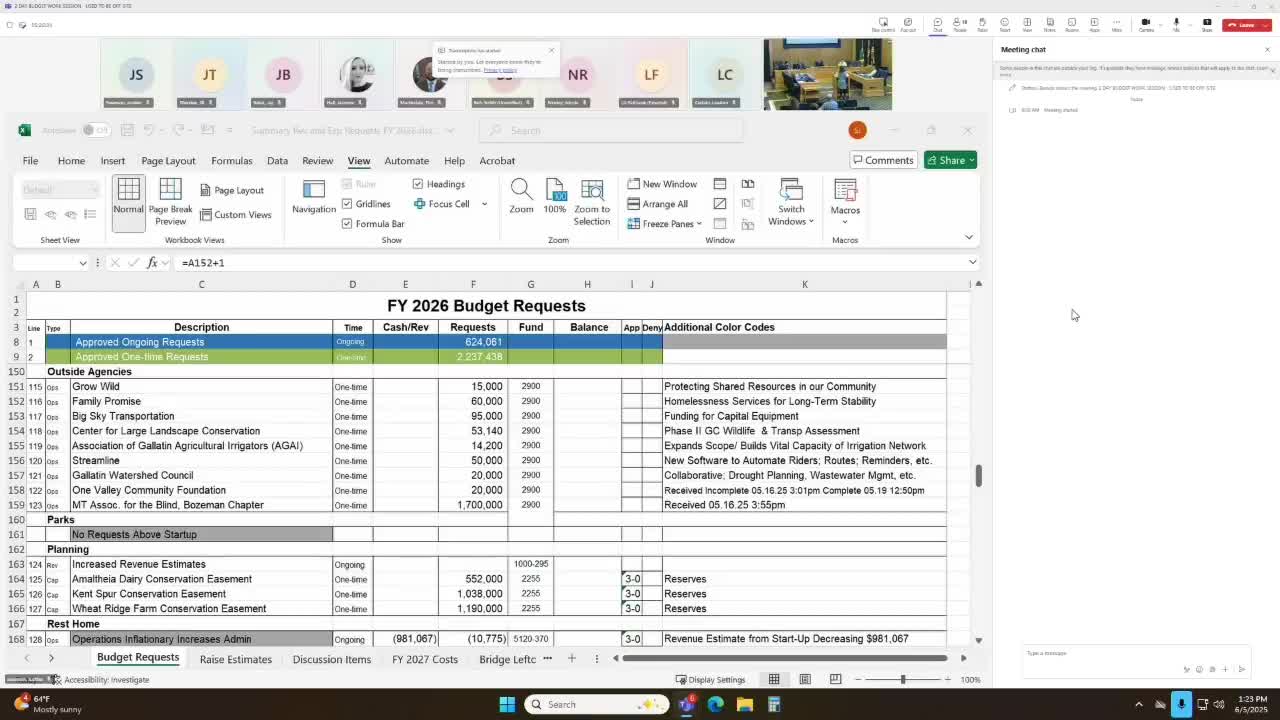Gallatin Watershed Council seeks $20000 for collaborative water management initiatives
June 06, 2025 | Gallatin County, Montana
This article was created by AI summarizing key points discussed. AI makes mistakes, so for full details and context, please refer to the video of the full meeting. Please report any errors so we can fix them. Report an error »

Gallatin County's budget meeting on June 6, 2025, spotlighted critical funding requests aimed at enhancing water resource management and conservation efforts in the region. The Gallatin Watershed Council (GWC) and Grow Wild, two key organizations, presented their cases for financial support, emphasizing the urgent need for collaborative stewardship of local ecosystems.
Holly, the executive director of the GWC, requested $20,000 to bolster the Gallatin Water Collaborative, which has expanded since its inception in 2021 to include over 100 stakeholders from various sectors. This funding would enable the GWC to continue vital initiatives such as flood mitigation, water quality enhancement, and habitat restoration. Holly highlighted the importance of integrating collaborative water management recommendations into upcoming county planning efforts, particularly zoning reforms. "County funds would support GWC staff and a contracted facilitator to continue coordinating the collaborative's efforts," she stated, underscoring the significance of their work in protecting the Lower Gallatin Watershed.
Jennifer Moller, director of Grow Wild, also addressed the commissioners, advocating for continued support for their nonprofit organization dedicated to conserving native species and managing noxious weeds in the Upper Gallatin Watershed. Moller pointed out the direct link between land management practices and water quality, citing a study that revealed a staggering 85% of annual water use in certain areas was dedicated to landscape irrigation. "We provide free land visits to help identify and manage noxious weeds and promote native landscaping," she explained, emphasizing the organization's role in educating the community about sustainable practices.
Both organizations reported significant outreach successes, with Grow Wild noting a 115% increase in youth engagement and a 57% rise in adult education over the past year. Moller concluded by stressing the necessity of funding for land stewardship, particularly in a resort community where resources are limited.
The discussions at the meeting highlighted the critical intersection of water management, community education, and environmental conservation, setting the stage for potential funding decisions that could significantly impact the health of Gallatin County's natural resources.
Holly, the executive director of the GWC, requested $20,000 to bolster the Gallatin Water Collaborative, which has expanded since its inception in 2021 to include over 100 stakeholders from various sectors. This funding would enable the GWC to continue vital initiatives such as flood mitigation, water quality enhancement, and habitat restoration. Holly highlighted the importance of integrating collaborative water management recommendations into upcoming county planning efforts, particularly zoning reforms. "County funds would support GWC staff and a contracted facilitator to continue coordinating the collaborative's efforts," she stated, underscoring the significance of their work in protecting the Lower Gallatin Watershed.
Jennifer Moller, director of Grow Wild, also addressed the commissioners, advocating for continued support for their nonprofit organization dedicated to conserving native species and managing noxious weeds in the Upper Gallatin Watershed. Moller pointed out the direct link between land management practices and water quality, citing a study that revealed a staggering 85% of annual water use in certain areas was dedicated to landscape irrigation. "We provide free land visits to help identify and manage noxious weeds and promote native landscaping," she explained, emphasizing the organization's role in educating the community about sustainable practices.
Both organizations reported significant outreach successes, with Grow Wild noting a 115% increase in youth engagement and a 57% rise in adult education over the past year. Moller concluded by stressing the necessity of funding for land stewardship, particularly in a resort community where resources are limited.
The discussions at the meeting highlighted the critical intersection of water management, community education, and environmental conservation, setting the stage for potential funding decisions that could significantly impact the health of Gallatin County's natural resources.
View full meeting
This article is based on a recent meeting—watch the full video and explore the complete transcript for deeper insights into the discussion.
View full meeting
